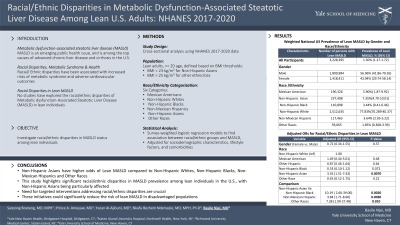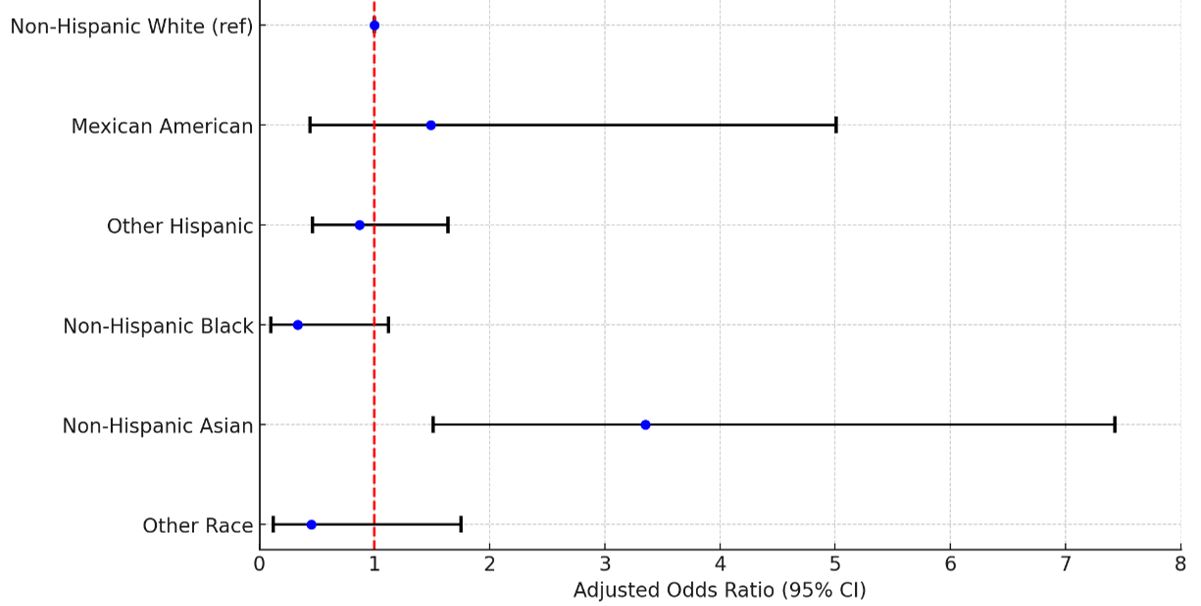Monday Poster Session
Category: Liver
P2978 - Racial/Ethnic Disparities in Metabolic Dysfunction-Associated Steatotic Liver Disease Among Lean US Adults
Monday, October 28, 2024
10:30 AM - 4:00 PM ET
Location: Exhibit Hall E

Has Audio

Basile Njei, MD
Yale University School of Medicine
New Haven, CT
Presenting Author(s)
Sarpong Boateng, MD, MPH1, Prince A. Ameyaw, MD1, Yazan Al-Ajlouni, MD2, Nkafu Bechem Ndemazie, MD, MPH, Ph.D3, Basile Njei, MD4
1Yale New Haven Health, Bridgeport Hospital, Bridgeport, CT; 2Staten Island University Hospital, Northwell Health, New York, NY; 3Richmond University Medical Center, Staten Island, NY; 4Yale University School of Medicine, New Haven, CT
Introduction: Metabolic dysfunction-associated steatotic liver disease (MASLD) is an emerging public health issue with observed disparities across racial, ethnic, and gender groups. This study aims to determine the prevalence of MASLD among lean individuals by gender and various racial and ethnic groups using data from the National Health and Nutrition Examination Survey (NHANES) 2017-2020.
Methods: A cross-sectional analysis was performed using NHANES 2017-2020 data. Lean individuals were defined using body mass index (BMI) thresholds: BMI < 23 for non-Hispanic Asians and BMI < 25 for other ethnicities. We excluded individuals with history of chronic or active viral hepatitis, significant alcohol use. Survey-weighted logistic regression models were used to evaluate the association between MASLD status and gender, race, and ethnicity, adjusting for sociodemographic characteristics and medical history.
Results: Among 1,707 lean participants, the mean age was 44.4 ± 19.95 years, with 47.9% being male. Non-Hispanic Whites comprised 39.2% of the sample, followed by Non-Hispanic Blacks (25.2%), Mexican Americans (16.9%), Non-Mexican Hispanics (8.4%), Non-Hispanic Asians (13.1%), and Other Races (5.7%). No significant difference in MASLD prevalence was found between genders (OR = 0.72, 95% CI: 0.34-1.55, p = 0.368). However, after adjusting for age, education, smoking, physical activity, hypertension and depression, significant racial and ethnic disparities were observed. Non-Hispanic Asians had significantly higher odds of lean MASLD compared to non-Hispanic Whites (OR = 3.35, 95% CI: 1.51-7.43, p = 0.007). Pairwise comparisons revealed that Non-Hispanic Asians had higher odds of MASLD compared to Non-Mexican Hispanics (OR = 3.84, 95% CI: 1.71-8.60, p = 0.003), Non-Hispanic Blacks (OR = 10.19, 95% CI: 2.66-39.00, p = 0.002), and Other Races (OR = 7.38, 95% CI: 1.99-27.48, p = 0.010).
Discussion: This study highlights significant racial and ethnic disparities in MASLD prevalence among lean individuals in the United States, with non-Hispanic Asians being particularly affected. These findings emphasize the need for targeted public health interventions to address these disparities and improve liver health outcomes across all populations, including racial/ethnic minorites

Note: The table for this abstract can be viewed in the ePoster Gallery section of the ACG 2024 ePoster Site or in The American Journal of Gastroenterology's abstract supplement issue, both of which will be available starting October 27, 2024.
Disclosures:
Sarpong Boateng, MD, MPH1, Prince A. Ameyaw, MD1, Yazan Al-Ajlouni, MD2, Nkafu Bechem Ndemazie, MD, MPH, Ph.D3, Basile Njei, MD4. P2978 - Racial/Ethnic Disparities in Metabolic Dysfunction-Associated Steatotic Liver Disease Among Lean US Adults, ACG 2024 Annual Scientific Meeting Abstracts. Philadelphia, PA: American College of Gastroenterology.
1Yale New Haven Health, Bridgeport Hospital, Bridgeport, CT; 2Staten Island University Hospital, Northwell Health, New York, NY; 3Richmond University Medical Center, Staten Island, NY; 4Yale University School of Medicine, New Haven, CT
Introduction: Metabolic dysfunction-associated steatotic liver disease (MASLD) is an emerging public health issue with observed disparities across racial, ethnic, and gender groups. This study aims to determine the prevalence of MASLD among lean individuals by gender and various racial and ethnic groups using data from the National Health and Nutrition Examination Survey (NHANES) 2017-2020.
Methods: A cross-sectional analysis was performed using NHANES 2017-2020 data. Lean individuals were defined using body mass index (BMI) thresholds: BMI < 23 for non-Hispanic Asians and BMI < 25 for other ethnicities. We excluded individuals with history of chronic or active viral hepatitis, significant alcohol use. Survey-weighted logistic regression models were used to evaluate the association between MASLD status and gender, race, and ethnicity, adjusting for sociodemographic characteristics and medical history.
Results: Among 1,707 lean participants, the mean age was 44.4 ± 19.95 years, with 47.9% being male. Non-Hispanic Whites comprised 39.2% of the sample, followed by Non-Hispanic Blacks (25.2%), Mexican Americans (16.9%), Non-Mexican Hispanics (8.4%), Non-Hispanic Asians (13.1%), and Other Races (5.7%). No significant difference in MASLD prevalence was found between genders (OR = 0.72, 95% CI: 0.34-1.55, p = 0.368). However, after adjusting for age, education, smoking, physical activity, hypertension and depression, significant racial and ethnic disparities were observed. Non-Hispanic Asians had significantly higher odds of lean MASLD compared to non-Hispanic Whites (OR = 3.35, 95% CI: 1.51-7.43, p = 0.007). Pairwise comparisons revealed that Non-Hispanic Asians had higher odds of MASLD compared to Non-Mexican Hispanics (OR = 3.84, 95% CI: 1.71-8.60, p = 0.003), Non-Hispanic Blacks (OR = 10.19, 95% CI: 2.66-39.00, p = 0.002), and Other Races (OR = 7.38, 95% CI: 1.99-27.48, p = 0.010).
Discussion: This study highlights significant racial and ethnic disparities in MASLD prevalence among lean individuals in the United States, with non-Hispanic Asians being particularly affected. These findings emphasize the need for targeted public health interventions to address these disparities and improve liver health outcomes across all populations, including racial/ethnic minorites

Figure: Forest Plot of Adjusted ORs for Racial/Ethnic Disparities in MASLD StatusAmong Lean Individuals
Note: The table for this abstract can be viewed in the ePoster Gallery section of the ACG 2024 ePoster Site or in The American Journal of Gastroenterology's abstract supplement issue, both of which will be available starting October 27, 2024.
Disclosures:
Sarpong Boateng indicated no relevant financial relationships.
Prince Ameyaw indicated no relevant financial relationships.
Yazan Al-Ajlouni indicated no relevant financial relationships.
Nkafu Bechem Ndemazie indicated no relevant financial relationships.
Basile Njei indicated no relevant financial relationships.
Sarpong Boateng, MD, MPH1, Prince A. Ameyaw, MD1, Yazan Al-Ajlouni, MD2, Nkafu Bechem Ndemazie, MD, MPH, Ph.D3, Basile Njei, MD4. P2978 - Racial/Ethnic Disparities in Metabolic Dysfunction-Associated Steatotic Liver Disease Among Lean US Adults, ACG 2024 Annual Scientific Meeting Abstracts. Philadelphia, PA: American College of Gastroenterology.
